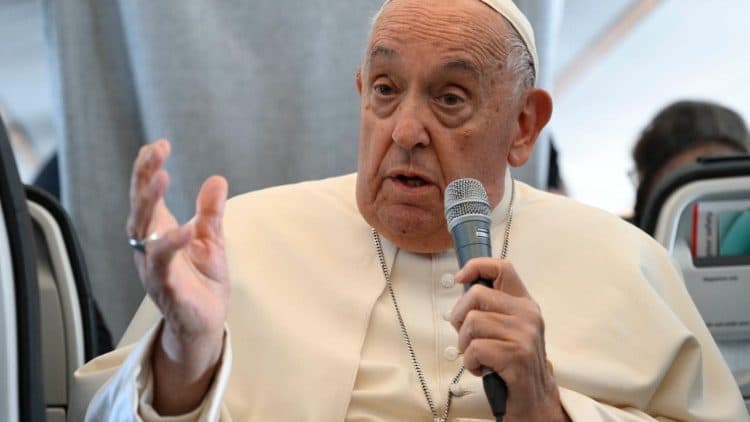ROME – A few days ago, Pope Francis said something which, ironically, his most ferocious critics on the far Catholic right likely would be the first to endorse. Reacting to criticism of his rhetoric on women during a trip to Belgium, he bristled at the idea that it reflected a “conservative” mentality.
“If this, to those women, seems conservative, [then] I am Carlo Gardel,” he said, referring to a famed French-Argentine Tango musician, which was a colloquially Argentinian way of saying he found the idea absurd.
Catholicism’s most ardent conservatives almost certainly would concur: Pope Francis, they will assure you – at great length, and with deep fervor and conviction – is not one of them.
(Ironically, the pope harumphed over the idea he’s a “conservative” in the same airborne news conference in which, once again, he defined abortion as “murder” and doctors who perform abortions as “hitmen,” rhetoric that most ordinary people might take as fairly conservative – but more on that below.)
It’s almost gratuitous to cite for-instances, but among the more celebrated points on the conservative bill of indictment against this pope would be Amoris laetitia, his 2016 exhortation opening a cautious door to communion for divorced and civilly remarried Catholics, and more recently Fiducia Supplicans, a document of the Dicastery for the Doctrine of the Faith green-lighting blessings for persons in same-sex unions. That’s in addition to his appointments of bishops to high-profile positions, almost all of whom are perceived as leaning to the left, and his embrace of leftist populist movements while scorning the traditional Latin Mass crowd.
Given all that, why did Pope Francis find himself in the seemingly odd position of having to reject the idea that he’s a conservative? In a nutshell, it’s the distinction between secular and Catholic versions of what counts as a “liberal,” which forever seeds confusion in media commentary and watercooler chatter alike.
For a typical secularist, a “liberal” implies, among other things, someone with permissive stands on what in the West we’ve come to call the “culture wars.” For secular opinion, a “liberal” is someone who’s pro-choice; pro-LGBTQ+, including support for gay marriage; and pro-women’s rights, including seeing any religious group that bars women from ministry as retrograde and patriarchal.
By that standard, it has to be said, there are virtually no “liberals” at all in the leadership structure of the Catholic Church.
While some Catholic bishops lean more heavily on pro-life causes than others, and some might even make a case for a distinction between personal convictions and civil law, virtually no Catholic prelate would describe abortion as a positive good or campaign for abortion on demand. (I say “virtually” because, with more than 5,000 Catholic bishops in the world, there’s at least one exception to pretty much every rule.)
Similarly, while many Catholic bishops have made outreach to the LGBTQ+ community an aspect of their ministry, few are pushing for the Catholic Church to celebrate gay marriages. The vast majority uphold the Church’s teaching that marriage is a sacrament between a man and a woman, and simply want to find other ways to make LGBTQ+ individuals feel welcome.
While there have been a handful of Catholic bishops over the years who have endorsed the idea of women priests, they’re a tiny fraction of the episcopacy. Most progressive-leaning prelates accept the priesthood as a sacrament for men, focusing their energies on combatting clericalism and finding other ways to empower women.
In other words, the secular contrast between “liberal” and “conservative” doesn’t work inside the Catholic Church, at least in its most senior ranks, because a distinction that ends up not actually distinguishing is fatuous.
Yet there certainly is a meaningful distinction between “liberals” and “conservatives” in the Church, as long as we apply Catholic, rather than secular, ways of reckoning the difference.
A liberal prelate, for instance, might argue that the Church places too much emphasis on the abortion issue, and that rather than fighting for legal bans on abortion, a more constructive and compassionate use of resources would be to find new ways to support pregnant women and families.
Rather than advocating gay marriage, a liberal bishop might support blessing gay unions – and thus defend Fiducia Supplicans from its critics on the Catholic right. Rather than pushing for women priests, a liberal might look for other ways of putting women in positions of power.
In broader strokes, a liberal Catholic bishop is someone open to the idea of the development of doctrine, and who believes the Church must, to some extent, adapt to its circumstances in order to remain relevant. A conservative, meanwhile, is someone who would put the accent on preservation rather than adaptation, worrying that when relevance supplants fidelity as the goal, it’s a prescription for watering down the faith.
To put the point differently, understandings of “left” and “right” ultimately depend on where you place the center. In secular culture, the center is defined mostly by public opinion at a given moment. In Catholicism, the center is defined by the catechism, with the debate being over how to interpret and apply its teachings.
Here’s how I try to explain it to my colleagues in the secular media, who are forever calling to ask some version of the following question: “I thought Francis was supposed to be a liberal … so what’s up with x?”
“Yeah, he’s a liberal alright,” I generally respond, “as long as we’re speaking Catholic, not American or European.”
That capacity to “speak Catholic” is key to getting many things about the Church right … including, in this instance, the pope. And if that’s not true, then I’m Carlo Gardel.















